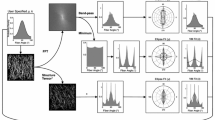Abstract
The semi-circular von Mises distribution is widely used to describe the unimodal planar organization of fibers in thin soft tissues. However, it cannot accurately describe the isotropic subpopulation of fibers present in such tissues, and therefore an improved mathematical description is needed. We present a modified distribution, formed as a weighted mixture of the semi-circular uniform distribution and the semi-circular von Mises distribution. It is described by three parameters: β, which weights the contribution from each mixture component; k, the fiber concentration factor; and θ p , the preferred fiber orientation. This distribution was used to fit data obtained by small-angle light scattering experiments from various thin soft tissues. Initial use showed that satisfactory fits of fiber distributions could be obtained (error generally < 1%), but at the cost of non-physically meaningful values of k and β. To address this issue, an empirical constraint between the parameters k and β was introduced, resulting in a constrained 2-parameter fiber distribution. Compared to the 3-parameter distribution, the constrained 2-parameter distribution fits experimental data well (error generally < 2%) and had the advantage of producing physically meaningful parameter values. In addition, the constrained 2-parameter approach was more robust to experimental noise. The constrained 2-parameter fiber distribution can replace the semi-circular von Mises distribution to describe unimodal planar organization of fibers in thin soft tissues. Inclusion of such a function in constitutive models for finite element simulations should provide better quantitative estimates of soft tissue biomechanics under normal and pathological conditions.
Similar content being viewed by others
References
Abahussin M, Hayes S et al (2009) 3D collagen orientation study of the human cornea using X-ray diffraction and femtosecond laser technology. Invest Ophthalmol Vis Sci 50(11): 5159–5164
Aghamohammadzadeh H, Newton RH et al (2004) X-ray scattering used to map the preferred collagen orientation in the human cornea and limbus. Structure 12(2): 249–256
Bowes LE, Jimenez MC et al (1999) Collagen fiber orientation as quantified by small angle light scattering in wounds treated with transforming growth factor-beta2 and its neutralizing antibody. Wound Repair Regen 7(3): 179–186
Chien JCW, Chang EP (1972) Small-angle light scattering of reconstituted collagen. Macromolecules 5(5): 610–617
Cortes DH, Lake SP et al (2010) Characterizing the mechanical contribution of fiber angular distribution in connective tissue: comparison of two modeling approaches. Biomech Model Mechanobiol 9(5): 651–658
Ferdman AG, Yannas IV (1993) Scattering of light from histologic sections: a new method for the analysis of connective tissue. J Invest Dermatol 100(5): 710–716
Fisher NI (1993) Statistical analysis of circular data. Cambridge University Press, Cambridge
Fung YC (1993) Biomechanics mechanical properties of living tissues. Springer, New York
Gasser TC, Ogden RW et al (2006) Hyperelastic modelling of arterial layers with distributed collagen fibre orientations. J R Soc Interface 3: 15–35
Girard MJ, Dahlmann A et al (2010) Quantitative mapping of scleral fiber orientation in normal rat eyes. Invest Ophthalmol Vis Sci 51(5): 2128
Girard MJ, Downs JC et al (2009) Peripapillary and posterior scleral mechanics-part II: experimental and inverse finite element characterization. J Biomech Eng 131(5): 051012
Girard MJ, Downs JC et al (2009) Peripapillary and posterior scleral mechanics-part I: development of an anisotropic hyperelastic constitutive model. J Biomech Eng 131(5): 051011
Girard MJ, Suh JK et al (2009) Scleral biomechanics in the aging monkey eye. Invest Ophthalmol Vis Sci 50(11): 5226–5237
Grytz R, Meschke G (2010) A computational remodeling approach to predict the physiological architecture of the collagen fibril network in corneo-scleral shells. Biomech Model Mechanobiol 9(2): 225–235
Grytz R, Meschke G et al (2010) The collagen fibril architecture in the lamina cribrosa and peripapillary sclera predicted by a computational remodeling approach. Biomech Model Mechanobiol
Hayes S, Boote C et al (2007) A study of corneal thickness, shape and collagen organisation in keratoconus using videokeratography and X-ray scattering techniques. Exp Eye Res 84(3): 423–434
Joyce EM, Liao J et al (2009) Functional collagen fiber architecture of the pulmonary heart valve cusp. Ann Thorac Surg 87(4): 1240–1249
McCally RL, Farrell RA (1982) Structural implications of small-angle light scattering from cornea. Exp Eye Res 34(1): 99–113
Meek KM, Boote C (2009) The use of X-ray scattering techniques to quantify the orientation and distribution of collagen in the corneal stroma. Prog Retin Eye Res 28(5): 369–392
Nguyen TD, Boyce BL (2011) An inverse finite element method for determining the anisotropic properties of the cornea. Biomech Model Mechanobiol 10(3): 323–337
Pandolfi A, Holzapfel GA (2008) Three-dimensional modeling and computational analysis of the human cornea considering distributed collagen fibril orientations. J Biomech Eng 130(6): 061006
Pierce DM, Trobin W et al (2010) DT-MRI based computation of collagen fiber deformation in human articular cartilage: a feasibility study. Ann Biomed Eng 38(7): 2447–2463
Price KV, Storn RM et al (2005) Differential evolution. A practical approach to global optimization. Springer, Berlin
Raghupathy R, Barocas VH (2009) closed-form structural model of planar fibrous tissue mechanics”. J Biomech 42(10): 1424–1428
Pierce DM, Trobin W et al (2010) DT-MRI based computation of collagen fiber deformation in human articular cartilage: a feasibility study. Ann Biomed Eng 38(7): 2447–2463
Sacks MS, Smith DB et al (1997) A small angle light scattering device for planar connective tissue microstructural analysis. Ann Biomed Eng 25(4): 678–689
Timmins LH, Wu Q et al (2010) Structural inhomogeneity and fiber orientation in the inner arterial media. Am J Physiol Heart Circ Physiol 298(5): H1537–H1545
Author information
Authors and Affiliations
Corresponding author
Rights and permissions
About this article
Cite this article
Gouget, C.L.M., Girard, M.J. & Ethier, C.R. A constrained von Mises distribution to describe fiber organization in thin soft tissues. Biomech Model Mechanobiol 11, 475–482 (2012). https://doi.org/10.1007/s10237-011-0326-y
Received:
Accepted:
Published:
Issue Date:
DOI: https://doi.org/10.1007/s10237-011-0326-y




